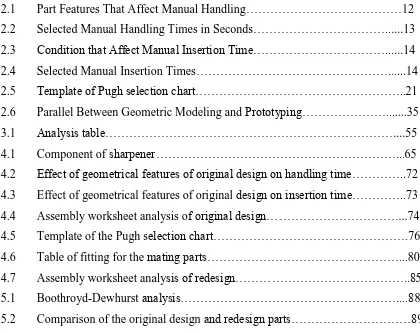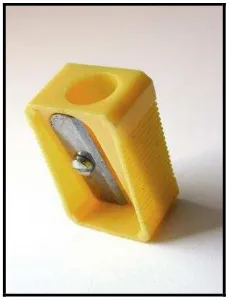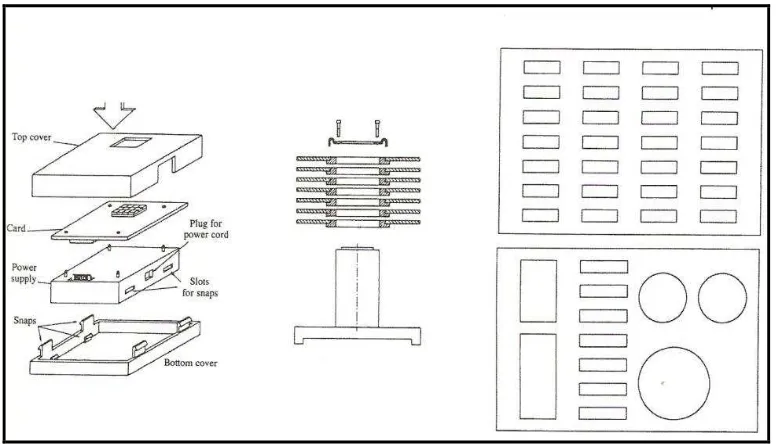i
UNIVERSITI TEKNIKAL MALAYSIA MELAKA (UTeM)
BORANG PENGESAHAN STATUS TESIS*
JUDUL: RE-DESIGN OF A PRODUCT USING BOOTHROYD DFA APPROACH .
SESI PENGAJIAN: 2008/2009
Saya NURUL AIN BT. ISMAIL
mengaku membenarkan tesis (PSM) ini disimpan di Perpustakaan Universiti Teknikal Malaysia Melaka (UTeM) dengan syarat-syarat kegunaan seperti berikut:
1. Tesis adalah hak milik Universiti Teknikal Malaysia Melaka.
2. Perpustakaan Universiti Teknikal Malaysia Melaka dibenarkan membuat salinan untuk tujuan pengajian sahaja.
3. Perpustakaan dibenarkan membuat salinan tesis ini sebagai bahan pertukaran antara institusi pengajian tinggi. atau kepentingan Malaysia yang termaktub di dalam AKTA RAHSIA RASMI 1972)
* Tesis dimaksudkan sebagai tesis bagi Ijazah Doktor Falsafah dan Sarjana secara penyelidikan, atau disertasi bagi pengajian secara kerja kursus dan penyelidikan, atau Laporan Projek Sarjana Muda (PSM). ** Jika tesis ini SULIT atau TERHAD, sila lampirkan surat daripada pihak berkuasa/organisasi berkenaan dengan menyatakan sekali sebab dan tempoh tesis ini perlu dikelaskan sebagai SULIT atau TERHAD.
ii
DECLARATION
I hereby, declared this report entitled “Redesign of a Product Using Boothroyd DFA Approach‟ is the result of my own research except as cited in references.
Signature: ………..
iii
APPROVAL
This PSM submitted to the senate of UTeM and has been partial fulfillment of the requirements for the degree of Bachelor of Manufacturing Engineering (Manufacturing
Design). The member of the supervisory committee is a follow:
……….
Mr. Ismail Abu Shah Project Supervisor
iv
ABSTRACT
v
ABSTRAK
vi
DEDICATION
For my beloved family:
Ismail Bin Muhaiyiddin Noraida Binti Mohamed Sabri
Muhamad Faisal Bin Ismail Muhamad Fairuz Bin Ismail
Farzana Binti Ismail Muhamad Firdaus Bin Ismail
vii
ACKNOWLEDGEMENT
In the Name of ALLAH The Most Gracious, Most Merciful,
First of all, thanks to ALLAH S.W.T. to give me chance and strength to accomplish to research of my final year project.
Special thanks to Mr. Ismail Abu Shah, lecturer of the Faculty of Manufacturing Engineering, University Technical Malaysia, Melaka as being my supervisor for my final year project 1 and 2. I also would like to thanks to Mr. Tajul Ariffin Abdullah as being my second supervisor for my final year project. I would like to express my greatest gratitude to my both supervisor, for their valuable guidance and continuing support throughout the entire course of my work.
viii
Overview of product the product suggestion……….3
ix CHAPTER 2
LITERATURE REVIEW
Historical Background………7
History Of Design For Manufacturing / Assembly (DFM, DFA, DFMA)……….7
Product structure………..8
The Boothroyd Method………....12
Design For Manufacturing / Assembly (DFM, DFA, DFMA)……16
What is Design for Assembly, (DFA)?...17
Concurrent engineering………17
Concurrent engineering fundamentals………18
Benefit of DFA for product designer ………...26
What Is Assembly?...27
x
4.2 Assembly process for original design……….68
4.2.1 Classification systems……….69
4.2.1.1 Effect of part symmetry, thickness and size...69
4.2.1.2 Effect of holding down………71
4.3 Concept Selection………75
4.3.1 Limit Dimensioning and Fits For Mating Components………..80
4.4 Assembly Process for New Design……….84
4.5 New redesign of product by using rapid prototyping process…………86
CHAPTER 5 5.0 DISCUSSION 5.1 Quantitative and qualitative comparison of the redesign and original design………..87
5.1.1 Boothroyd- Dewhurst analysis………88 6.0 CONCLUSION………..90
REFERENCES...91
xi
LIST OF TABLE
2.1 Part Features That Affect Manual Handling………12
2.2 Selected Manual Handling Times in Seconds………...13
2.3 Condition that Affect Manual Insertion Time………...14
2.4 Selected Manual Insertion Times………...14
2.5 Template of Pugh selection chart………..21
2.6 Parallel Between Geometric Modeling and Prototyping………...35
3.1 Analysis table………....55
4.1 Component of sharpener………...65
4.2 Effect of geometrical features of original design on handling time…………..72
4.3 Effect of geometrical features of original design on insertion time…………..73
4.4 Assembly worksheet analysis of original design………...74
4.5 Template of the Pugh selection chart……….76
4.6 Table of fitting for the mating parts………...80 4.7 Assembly worksheet analysis of redesign………..85
5.1 Boothroyd-Dewhurst analysis………....88
xii
LIST OF FIGURE
1.1 Pencil Sharpener………..3
2.1 The Example of Stack and Array Product Structures………..9
2.2 Initial design had 41 parts and estimated assembly time of 6.37 min………..23
2.3 An estimated assembly time of 2.58 min for a 59% reduction in assembly time……….24
2.4 Assembly Process Planning……….30
2.5 The Architecture for Assembly Production Optimization………...31
2.6 Manual assembly……….32
2.7 Mechanical Assembly Or Special-Purpose Transfer Machine Assembly……….32
2.8 Robotic Assembly………...33
2.9 Geometric Features Affecting Part Handling………..38
2.10 Some Other Features Affecting Part Handling………38
2.11 Provision Of Self-Locating Features to Avoid Holding Down and Alignment……...38
2.12 Rotational Symmetry of A Part………...39
2.13 Object with R Not Equal to Zero……….41
2.14 Object with Ix Not Equal to Iz………41
3.1 Flow chart………...51
3.2 Exploded view……….54
4.1 Tree Structure of the Original Design……….64
4.2 Assembly process for original design………..68
4.3 Thickness of Cylindrical and Non- Cylindrical Part………...70
4.4 Dimension Size of Part………71
xiii
4.6 Tree Structure of the Redesign 2 (Press Fit)………...78
4.7 Tree Structure of the Redesign 3 (Snap/ Medium Fit)………79
4.8 Exploded View of Redesign………84
4.9 Product in Prototyping……….86
xv
TM -Total manual assembly time / operation time UK -United Kingdom
1
CHAPTER 1
INTRODUCTION
This chapter provides the background of the project that includes overview of the product suggestion, problems statement, objectives, scope and importance of the study.
1.1 Project Background
Nowadays, design for manufacturing and assembly, DFMA is quite important according the current issue about the increasing of the price for consumer‟s good. Besides that, the highest price of the petrol and diesel at the market also give effect to consumer especially who have a lower income per month. If this problem still going on, maybe it will make hard for consumer to get the things that they require. For example, when they need to buy something, consequently will spend a lot of money to have it.
The term DFMA comes with the combination of DFA (design for assembly) and DFM (design for manufacturing). The basic concept of it is that the design engineers apply the DFMA paradigm of software to analyses the manufacturing and assembly problems at early design stage. By this means, all of consideration about the factors that affect the final outputs occurs as early as possible in the design cycle. The extra time spent in the early design stage is much less the time that will be spent in the repeat redesign. And meanwhile, the cost will be reduced.
2 speed, low cost and productivity. DFA is a kind of design paradigm with which, the engineer use all kinds of methods such as analyze, estimating, planning and simulating to consider all the factors that will affect the assembly process during the whole design process; revise the assembly constructions to satisfied the characteristics and functions of the final product and meanwhile, lower the cost as most as possible.
The aim of design for assembly (DFA) is to simplify the product so that the cost of assembly is reduced. However, consequences of applying DFA usually include improved quality and reliability, and a reduction in production equipment and part inventory. These secondary benefits often outweigh the cost reductions in assembly. Besides that to minimize part numbers, part variety, assembly surfaces, simplify assembly sequences, component handling and insertion, for faster and more reliable assembly. Furthermore, it also to reduce the total material cost, simplifies vendor selection, reduces labor content and assembly. It also simplifies the assembly process and factory layout.
Thus, DFA is one of is important particularly in manufacturing industry. Since it is one of the major sectors that contribute our country‟s economy and also gives opportunity to those who need a job. DFA has been most widely applied in industries with most impressive achievements. Since the prevalence of two well-known DFA tools Boothroyd–Dewhurst DFA and Lucas DFA in industries, significant developments have been attempted in several directions.
3 material cost in half, reduce investment in feeding and screwing tooling to one-fourth, and at the same time reduce the production lead time.
This project mainly focused to re-design of a product by using the Boothroyd DFA approach. The method used, because it provides a process of improving a product design for easy and low cost assembly. Besides that, it also focused on functionality and assemblability concurrently. For Boothroyd method, it will analyze whether the part can be considered a candidate for elimination or combination with other parts in the assembly.
At the end of this research, the best design of product will be determined by using the Boothroyd DFA approach. The design of product can minimize the number of parts in an assembly also ensure that the remaining parts are easy to assemble.
1.2 Overview of the Product
Figure 1.1: pencil sharpener
4
1.2.1 History Of Pencil Sharpener
Pencils were in use before the development of devices specifically to sharpen them. Previously, they were sharpened by shaving with a knife. Pencil sharpeners made this task much easier and gave a more uniform result. Some specialized types, such as a Carpenter's Pencil are still usually sharpened with a knife, due to their flat shape, though recently a fixed-blade device with a relatable collar has become available.
Bernard Lassimone, a French mathematician, applied for the first patent (French patent #2444) on pencil sharpeners in 1828. In 1847, Therry des Estwaux invented the manual pencil sharpener. Electric pencil sharpeners for offices have been made since at least 1917.
They now come in a wide array of colors and shapes. Now, it is common for traditional sharpeners to have a case around them so that the shavings do not fall; you can then remove this and empty the case.
1.2.2 Types of Pencil Sharpener
Handheld barrel pencil sharpener handheld metal pencil
5
Manual double hole cylinder pencil sharpener battery operated pencil sharpener
Modern pencil sharpener
1.3 Problem statement
Due to the current product design, the number of part counts of a product which too many will cause higher cost of a product. Therefore, to reduce the quantity of part, it will help to lower the product cost and at the same time the quality of the product is maintained.
1.4 Objectives
The objectives of this project are:
a) to simplify the design of the product
b) to quantify the outcomes in terms of cost, lead time and parts count
6
1.5 Scope of Study.
By using the Boothroyd Design for assembly approach
a) Using DFMA approach manual assembly to carry out DFA analysis
b) The analysis is broken down into two categories which is handling and from the point of view of assembly. This procedure results in simpler and more reliable products that less expensive to assemble. In addition, any reduction in the numbers of parts in an assembly produces a pencil sharpener effect on cost reduction because of the drawings and specifications that are no longer needed, the vendors that are no longer needed, and the inventory that is eliminated. All of these factors have an important effect on overheads, which in many cases; form the largest proportion of total cost of the product.
7
CHAPTER 2
LITERATURE REVIEW
2.1 Historical background
Engineering design is a process of developing a systems, component, or process to meet desired needs. The means of design is a complex iterative creative process that uses available resources, energy and technology to fulfill the original need within some set of defined constraints. It is a decision making process in which basic sciences, mathematics, and engineering technologies are applied to convert resources optimally to meet a stated objective (ABET, 1988). Engineering design had usually been completed purely based on the consideration of product functionality. The design was then passed from the design department to the assembly process-planning department and then to the manufacturing department. These activities were completed in a sequential manner with no feedback given to the designer. Sometimes the designed product is extremely difficult to manufacture and the manufacturing cost is unnecessarily high.
2.2 History of Design for Manufacturing / Assembly (DFM, DFA, DFMA)
8 many shortcoming in product and assembly process design. Only when automatic machinery and especially robots began to be considered for assembly did it become obvious that more attention needed to be paid to assembly itself.
The basic goals of DFM and DFA are to make fabrication and assembly easier, less costly, simpler, more reliable, and on. To achieve these goals, engineer must often modify their designs and expand their focus when designing so that factors other than product performance are seriously taken into account. Many engineers think that considering manufacturing or assembly will compromise product performance, and often they do not know enough about manufacturing and assembly to make the appropriated changes in their designs in order to achieve DFx goals. If engineers can carry out their own DFx analyses, they can protect product function and will probably learn that there is little chance that function will be seriously impaired. (Whitney,2004)
DFx in the large deals with issues that require consideration of the product as a whole, rather than individual parts in isolation, and likely will require consideration of the context in the factory, supply chain, distribution chain, and the rest of the product‟s life cycle and will be focus to (a) product structure and its relation to product simplification and (b) design for disassembly, repair, and recycling.
2.2.1 Product structure
9 Furthermore, the differences will extend beyond the local issue of assemble ability. Figure 2.1 show the example of stack and array product structures
Figure 2.1: Both stacks and arrays come in two generic varieties: the part are mostly the
same or mostly different. (Redford and Chal) copyright © Alan Redford
a) Simplification methods
As noted earlier, a major effort of DFA is product simplification. Simpler products have fewer parts, which mean fewer assembly operations, workstations, factory space, and workers. In addition, each part represents design effort and overhead. Whether, simpler/fewer always means less expensive is a separate issue discussed below.


